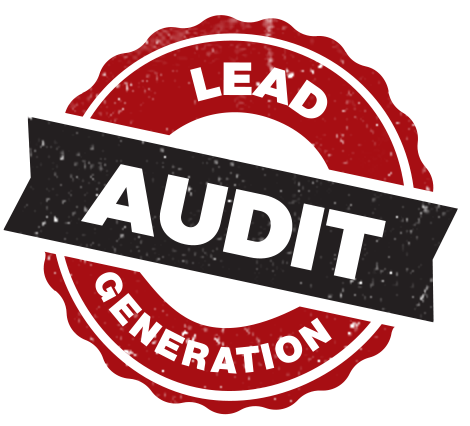Posted by Rich Harshaw on November 23, 2017.

Remember when Thanksgiving and Black Friday were their own separate things? You know, before Black Friday bled into Thanksgiving Thursday?
These two days used to synergize so well.
Here’s how things would go:
- 9am-4pm: Shove that 20lb turkey in the oven; get side dishes and dessert prepared.
- 5pm: Sit down to dinner with the family.
- 6:30pm: Trudge your bloated self to the living room to watch a little football. (That second piece of pumpkin pie? Not your best idea.)
- 7:30pm: Get annoyed when Uncle Bob starts talking politics after one too many beers.
- 8pm: Kick Uncle Bob out.
- 8:30: Clean up.
- 10pm: Go to bed to get plenty of rest for the 5am store opening times on Black Friday.
But over the past few years, this timeline has changed for some families.
Black Friday slowly started creeping backward, truncating Thanksgiving Day family festivities.
5am Friday openings became 2am Friday openings. Then 12am Friday openings. Then 10pm THURSDAY openings.
Today, many brick-and-mortar retailers open as early as 6pm on Thanksgiving Day. Some even earlier than that.
You can almost feel one of the only family-oriented holidays left being slowly killed by commercialism.
If you’re upset about that, I’ve got news for you: retailers don’t care. And when I look at it from a business perspective, I can’t say I blame them.
Don’t get me wrong…
I LOVE spending time with my family on Thanksgiving. I LOVE watching the Dallas Cowboys with my sons every year. And camping in front of Best Buy for hours, days, or weeks to get deal on a TV is not my thing. But I also understand that companies like Best Buy now need to take drastic action to stay afloat.
Consider this: Nine brick-and-mortar retailers have filed for bankruptcy in 2017.
These are big names, too, like Sears, Macy’s, and J.C. Penny. The places you’ve shopped at for decades.
Meanwhile, Amazon’s sales have shot from $16 billion to $80 billion since 2010.
To stay competitive, brick-and-mortar stores have had to get cutthroat. And that means carving time out of Turkey Day.
Though in-store sales are slumping, Thanksgiving is now a HUGE day for stores. In 2015, 35 million people went out and shopped on Thanksgiving, resulting in billions of dollars in sales.
In addition, data shows 70% of consumer spending happens at the first two stores people visit on Thanksgiving/Black Friday.
So you can see why Thanksgiving is too important for brick-and-mortar retailers NOT to be open on.
These companies don’t care if some people think they are ruining the one day a year meant for family bonding. Those aren’t the people these businesses are targeting.
The ones they ARE targeting are those who don’t mind hitting up some stores for some deals after chowing down on some pumpkin pie and watching a little pigskin.
This strategy of “exclusion” is smart marketing. And it’s a tactic contractors should copy.

Focus on YOUR market.
Don’t worry about the rest.
Don’t worry about alienating people who wouldn’t buy from you anyway. You’ll never get their business, so who cares?
Instead, focus your marketing on YOUR customer demographic. Be specific about who you are, what you do, who you work for, and who you DON’T.
You can do this in a number of ways. Here are a few examples:
- Be up-front about having higher prices (and therefore higher quality). You’ll filter out the price shoppers, while landing the high-end affluent clients you want.
- Admit you may not be the fastest (but only because you take the time to do everything perfectly). You won’t have to worry about taking calls from homeowners who want a project done yesterday.
- If you do have lower prices, shout it from the rooftops. Spirit Airlines markets itself as a low-cost airline to attract clientele that doesn’t care about pretentious extras and “flying fancy.” If you do this, though, make sure you detail WHY you have lower prices. Do you keep your overhead low? Do you buy directly from the manufacturer? If so, say so. You want people to know that your prices are lower because you’re smart… not because you sacrifice quality.
- Make it abundantly clear that ALL you do is kitchen remodeling… or windows… or commercial roofing… or contractor marketing (wink, wink). You won’t have to waste time talking to people who want what you don’t offer.
Something to chew on before today’s Big Dinner.
Happy Thanksgiving!
Posted by Rich Harshaw on July 10, 2017.
.
A bathroom contractor once submitted this print advertisement to me for feedback:
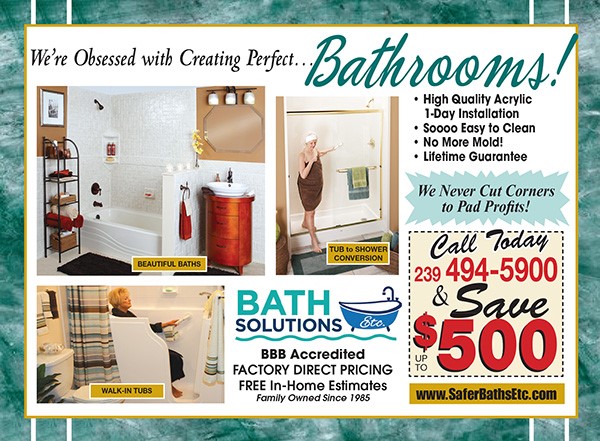
Two of my issues with this ad were…
1.) It was ugly.
2.) It looked exactly like the 56,432 other bathroom ads you see in newspapers and magazines.
But the most egregious sin this ad committed was who it targeted. Or, more accurately, that it targeted too many people.
I’ll explain.
The ad tries to reach several different markets at once. It wants you to know that the company can take on a variety of bathroom projects—from “beautiful baths” to “tub to shower conversions” to “walk-in tubs.”
As a result, the ad piqued no particular market’s interest. Thus, no one responded to it.
I had the following conversation with the bathroom remodeler about his ad’s lack of success…
Me: What percentage of your business are senior citizens, 60 years and older?
Bathroom Contractor: 60 percent to 70 percent
Me: Is that the kind of customers you’d like to continue to attract?
Bathroom Contractor: Yes.
Me: So why don’t you reach out to them specifically instead of throwing out this general stuff?
Bathroom Contractor: (head scratching)
Me: What is the biggest problem they have that you solve?
Bathroom Contractor: They can’t get their leg up over the tub to get in or out, or they are worried about slipping when they raise their leg.
Me: How about we just say that?
Bathroom Contractor: (mind explodes)

Eureka!
Sometimes the best ad is one that literally conveys what is going on in people’s heads. Because you’ve captured what they’re thinking, your message instantly becomes powerful and resonant.
After a little more digging, I found out that some of the company’s customers preferred to take baths, while others preferred showers—and that the company has products for either preference (walk-in tubs and low or zero-entry showers).
So I wrote the following text for the ad on the spot while on the phone with the client:
—
“It’s Hard To Raise My Leg Over The Tub…”
Finally, An Inexpensive Way To Make Bathing Easy & Worry-Free Again.
Our Patented Walk-In Tubs & Showers Solve Your Problem For Good.
Let’s face it, just getting in and out of the tub can be a major challenge. Slips and falls can and do (and will!) happen. Don’t wait until you have an accident to remove your tub and replace it with a SAFER alternative.
Prefer To Take Baths? If you prefer to take baths, convert to our patented WALK-IN TUB. It has a low-step door that perfectly seals water in while your bath remains perfectly safe. No more worrying. Stress-free bathing.
Prefer To Take Showers? We can pull your old tub out and replace it with a low-step (4 inches) or roll-in (zero inches) entry that eliminates the stress of getting in and out. Both models have optional seats & grab bars (recommended!) and non-slip surfaces for your safety.
We’ve been creating perfect bathrooms solutions for 40 years—we are preoccupied with perfection. We are adamant about excellence. We are fixated on flawless. Let us help you solve your bathroom safety concerns today.
—
Next, I had MYM’s design team put this text into an eye-catching advertisement. I couldn’t find a photo I liked for the ad, so I had my artist produce an illustration that captures the essence of the ad perfectly.
Here’s the final product:
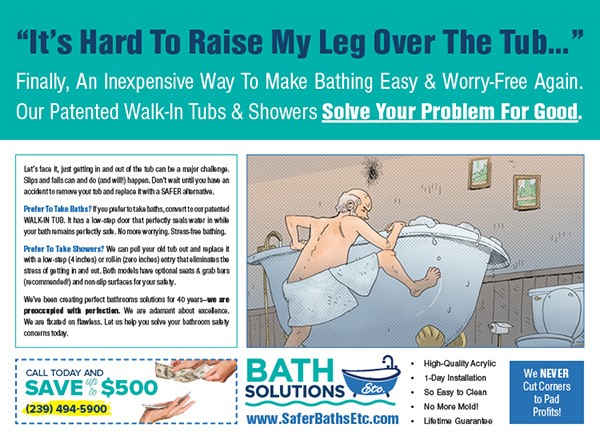
Wham, bam, thank you, ma’am: Now THAT’S an ad that reaches out and grabs readers. But not just any readers—the RIGHT readers.
Moral of the story: When it comes to marketing, speak directly to your target audience!
If you need ad creation that resonates with your audience and hits their “buy” buttons, you know who to turn to.
Save
Posted by Rich Harshaw on June 6, 2017.

Want to know the #1 reason contractors don’t close sales meetings?
Hint: It’s probably not what you’re thinking.
While “no money,” “needed more info,” and “bad timing” are all solid answers, they’re not the most common reason for sales meetings that end… well, without a sale.
Not. Even. Close.
The biggest reason people don’t buy during that initial meeting (which radically reduces the chance they’ll buy at all) is good old-fashioned sticker shock.

Yes, really. I’ll explain.
You are asking people for a lot more money than they were likely expecting you to. Though they may be able to afford it, the collision course of their flowery expectations with a (much) more expensive reality is enough to kill a sale.
Think about it…
Contractors sell a fairly expensive service that people don’t often buy. This means most homeowners don’t have a frame of reference for how much they should expect to pay. And when they don’t know, they tend to underestimate the cost.
So when you show up to sell to prospects, you have to cover a lot of ground to close that gap. This leads to frustratingly long sales cycles, sales meetings that stretch well beyond what they’re supposed to, and the prospect raising phantom objections (because they’re too scared to admit that, holy cow, this is more money than they were expecting!).
Here’s how you prevent sticker shock in your prospects and make closing ratios soar…
-
Utilize Pre-Positioning Materials
One of the best ways to quell sticker shock is to start building a case for the value of your services before you meet with the prospect.
You can do this by sending the prospect Pre-Positioning materials—informative sales materials and reports (printed work best, but PDF documents work in a pinch) that showcase a bit of your Identity while educating them on how to make good decisions for their home and project.
Two examples of Pre-Positioning materials we include provide our clients are the Contractor Standards Guide (a guide that helps homeowners choose the best contractor) and Product Reports (a brochure that provides specific info about a product you sell).
Contractor Standards Guide (Roofing Contractor)
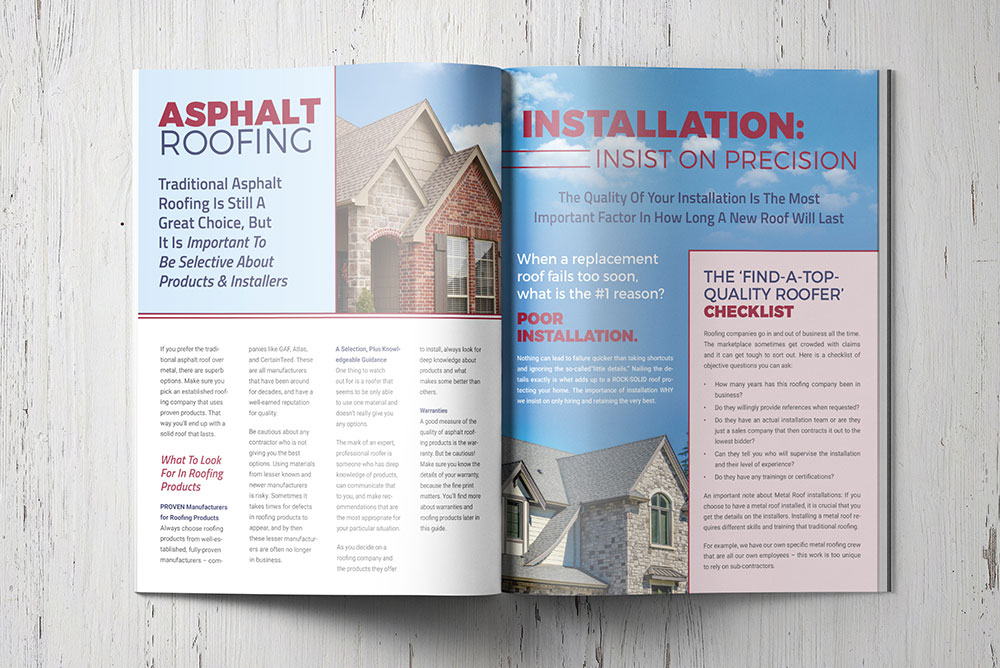
Product Guide (Hardwood Floors)
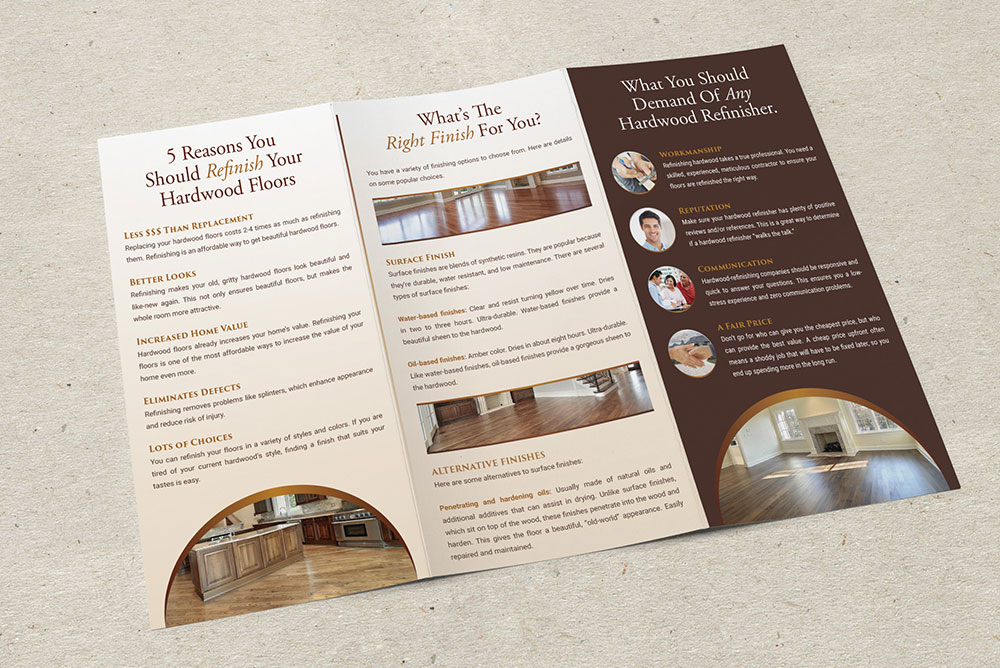
The goal of Pre-Positioning materials is lay out all the main points you’d make during the sales meeting to win them over on price. The key here is that you’re setting expectations BEFORE dropping a price on them. And since it’s in writing—rather than coming from a salesperson’s mouth—it has more credibility and authority.
-
Confirmation Calls
The next step is to make sure your prospect has read the Pre-Positioning materials before your meeting. When you call to confirm the sales appointment, ask the prospect if he’s had to review the materials you sent. Let him know about the important information he’ll find in the report, and direct him to the most relevant parts.
Don’t just say, “Hey, read this because you have the wrong idea about price and I don’t want to battle you on it.” Instead, frame yourself as the prospect’s advocate and tell him that the Pre-Positioning report will educate him on the right questions to ask during your meeting (or any sales meeting, for that matter).
-
Let Prospects Go Price Shopping
If you’re not able to close the deal at the appointment, by all means, let your prospect shop the competition with the Pre-Positioning materials you’ve armed him with. It may seem counterproductive, but if you’re a quality company, you should never be afraid to let an educated prospect shop around.
Besides, he already knows you may cost more than your competitors. And since you gave him the materials he needs to see that low price also means low quality, low service, and low reliability, there is a fantastic chance he’ll come back to YOU.
If you want to increase closing ratios, boost your average sales amount, and eliminate sticker shock in your prospects, click here to learn more about MYM’s Pre-Positioning package.
Save
Posted by Rich Harshaw on May 26, 2017.

Let’s say you and your spouse are watching TV. A commercial for a Disney cruise comes on.
You have three kids, and they’re at that perfect “Disney” age.
You start talking about how you’ve wanted to take your kids on a BIG vacation. You’ve even been saving some cash for it.
So the following day, as you’re driving to your travel agent (yes, you still have a travel agent in 2017—just go with it), you discuss the plan with your spouse and try to determine your budget.
Here’s what you talk about:
- You are unsure how much Disney cruises cost, but you assume they’re expensive. (Everything Disney is expensive.)
- You have friends that have been on a Disney cruise before, and they swore on a stack of Bibles it was the greatest experience ever. But the cost never came up in discussion.
- You have other friends who went on a Carnival cruise and loved it. Your friend is the kind who “finds deals” and said their all-inclusive cruise was only $380 per person for seven days. That’s $1,900 for five people.
- Since you know Disney will cost more (Mickey Mouse doesn’t entertain kids for free), and you know your friend is a bargain hound, you’re assuming that the Disney Cruise will probably be about DOUBLE the cost of your friend’s cruise—maybe as much as $4,000.
- You also know you need to fly to Florida where the ship launches… say that’s $300 per person, that will add another $1,500.
- You budget $500 for miscellaneous things and “fun stuff,” bringing your total maximum budget to $6,000.
- You’ve already saved up $3,000, and you think you can save another $1,500 prior to the trip, and you’ll just put the other $1,500 on a credit card that you’ll pay off as soon as you can.
Bing, bang, boom—you’re ready to speak with your travel agent.
The travel agent, of course, is thrilled to see you. She gets the dates and info from you and inputs it into her computer.
The following conversation ensues:
Travel Agent: Okay. It’s going to be… $10,783.80, including taxes. That’s a stateroom with a verandah.
You: (Gulp) What’s a stateroom with a verandah?
Travel Agent: Stateroom just means room; verandah means it has a little balcony you can sit on to view the ocean. Here is a picture. (She shows you the computer monitor).
You: That’s nice, but it might be out of our budget. (A single bead of sweat rolls down your forehead.)
Travel Agent: Well, that’s actually the cheapest price in July.
You: Uh, okay. Are there any, you know, less expensive staterooms? Maybe without a verandah?
Travel Agent: The cruise ship has interior rooms with no view or balcony. They are usually around $7,000 to $8,000. But they’re sold out for all of this month.
You: Uh, okay. Um, uh.
Travel Agent: If you could go later in the year, like in October, then these cheaper rooms would be available. Or you could go on a different cruise line—we have a Carnival Cruise in July for only $4,700. Disney does have a four-day cruise that is less money, but that is sold out, too.
You: Uh… uh… (exchanging nervous looks with your spouse)… okay. We need to think about it.
Travel Agent: Well, I’ll tell you what. I have been authorized to give you a 10% discount on any of these cruises if you decide and buy right now. Because, you know, if you do that, then I don’t have to waste time calling you back later. So which cruise do you want?
You: I… don’t know. I’d really like some time to think about it.
Travel Agent: We can finance it. Just put down $1,000, and we can do 0% financing for up to 18 months. Then you can afford the Disney Cruise you want. Which date would you like to book?
You: Heh, yea. Okay. I think we want to think about this. We’ll get back to you. (You run away and never look back.)
Let me ask you… whose fault is it that you didn’t buy?
Maybe the travel agent didn’t “sell” well enough. Maybe she didn’t ask for the sale in a firm enough fashion.
I’m sure if the travel agent’s sales manager asked, they would blame YOU for being “cheap” and “indecisive.” You couldn’t come to a decision, even when given multiple options in your price range and financing was offered.
This role play scenario is a microcosm of the ordeal many (probably MOST) contractors force their customers to go through in every sales meeting.
You ask them to pay much more money than they thought they would.
You use words and jargon that are foreign to them.
You throw a ton of choices at them that they don’t know how to sort through.
You try to make them decide something right away, when they really need is to step back, breath, and process.
I’ve got some advice…
Stop doing this.
There’s an old marketing adage: “If you want to know why John Smith buys what John Smith buys, you’ve got to see the world through John Smith’s eyes.”
Take a second to view the situation from your prospect’s standpoint:
- Know That They Don’t Know: Remember that your prospects know very little about what you sell—including pricing and options. Everyone knows a Chevy Malibu is probably $20,000 or $25,000. Almost no one has any idea how much a new kitchen or replacement windows cost.
- Facilitate Their Knowledge: Don’t make prospects wait for the sales meeting to find all this out—it’s overwhelming and unfair to them. On your website, provide information so they know you’re different (and better!) that your competitors. Give case studies, with as much detail as possible. Provide them with pre-positioning materials before your meeting, so they have a better idea of what to expect (more on that in a second).
- Take Responsibility: Don’t become frustrated when prospects don’t know something. Consider it your responsibility if they walk into a sales appointment unprepared.
- Give Them A Break: If they really do need more time, give them more time. This isn’t ideal, but neither is pressuring them. If you do your job on the front end, you won’t find yourself in this situation.
Ultimately, this all boils down to respect. If you respect your prospects as humans, you won’t force them into uncomfortable situations.
One of the best ways to educate prospects and lower their sales resistance is with Pre Positioning materials. These include items such as a Contractor Standards Guide, product brochures, and pre-appointment emails.
The idea is to get prospects familiar with your business BEFORE you walk through their front door. By doing so, you make them more prepared and at ease for your meeting. This increases your closing rates and helps you increase your average sales amount.
MYM provides contractors with a powerful, proven Pre-Positioning package.
Our Pre-Positioning materials soften up your prospects like microwaved butter, so you can keep more appointments, close more jobs, and boost your bottom line.
Visit our Pre-Positioning package webpage for the details.
P.S. Thursday’s email is for the contractors who follow MYM but haven’t yet become clients. I’ll unveil a website we just launched for one of our new clients. The client received bids from four online marketing companies (including MYM) to build them a new website… and they chose us. I’ll tell you why—and show you the client’s amazing new website—in a couple days.















